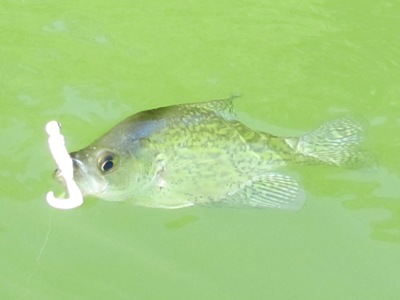Catching black crappie during the summer often requires considerably different strategies from spring fishing techniques. Crappie can be difficult to catch in summer, mostly because they are sometimes harder to locate. Unlike spring, when crappie seem to be everywhere, summer crappie tend to move into areas of cooler water and their presence may not be apparent to casual anglers.
In some areas, crappie can be so dispersed in summer that they become a fish of opportunity. One strategy that works for some anglers is to for other species, while keeping an eye out for crappie. When fish are finally located, anglers can respond quickly and target crappie.
One way to locate schools of summer crappie while fishing for bass or other species is to “dead stick” jigs or live minnows below the boat. Tandem jigs seem to work especially well with this technique. Although these offerings may lie still or move only slightly, their depth may be a vital key to crappie fishing success.
In open lakes and reservoirs, crappie are not always difficult to locate during the summer. Anglers often use electronic fish finders to scan various depths until schools of fish are located. Once fish are detected, anglers cast or jig lures to entice strikes.
Fish in the summer often orient around submerged limbs or other structure, sometimes in choose deeper locations than spring crappie.
In clear lakes and other large bodies of water, summer crappie can be picky about lure colors. Dedicated crappie anglers sometimes carry a large selection of jigs and soft plastic bodies which allows them to repeatedly switch colors and patterns until a consistent choice is found.
In addition to jigs, popular lures for catching crappie in summer include small metal jigs, deep running crankbaits, spinnerbaits, crawfish patterns, and tubes or small versions of plastic worms.
In summer, vegetation takes over many areas that were open to fishermen during the spring. Although aquatic vegetation makes fishing difficult, it mean excellent fishing for crappie and other species. In some areas, spadderdock, marsh grasses, submerged plants, or other vegetation forces anglers to use “crappie poles.” These long rods are equipped with a simple line, bobber, and hook.
Using small boats, anglers move slowly among the vegetation, searching for small openings. When a suitable clearing is located, a live minnow, cricket, or other bait is carefully lowered into the water. At the slightest movement of the bobber, the angler must heave the fish upward to avoid tangling with nearby obstructions.
Regardless of the structure where crappie are found, once a pattern is detected, fishing can be very successful. Most crappie specialists pay attention to fish behavior from day to day and cover a variety of potential habitats.
Related Information
